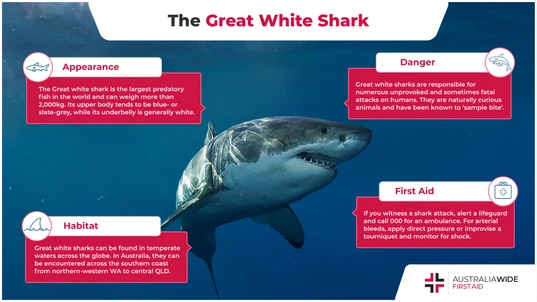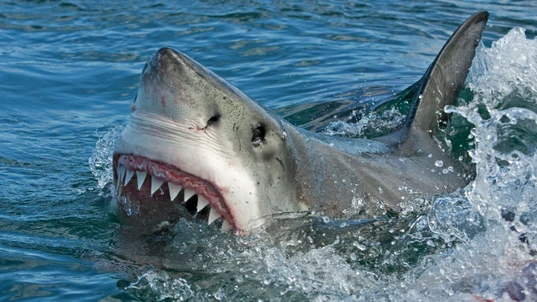Deadly Marine Life: The Great White Shark

Bites and Stings

The Great white shark is arguably the most well-known shark in the world. As the largest predatory fish in the world, and with strong jaws housing upwards of 300 highly serrated teeth, Great white sharks are indeed formidable predators.
Of the world’s 400 shark species, Australia is home to a whopping 170 of them. On top of that, our waters are host to the 12 shark species that are renowned for unprovoked attacks on humans, including the 3 species that have been responsible for fatal attacks in the past 20 years – the Bull shark, the Tiger shark, and the Great white shark. The Great white shark, as well as being the largest predatory fish in the world, is arguably the most well-known, due to its starring role in Steven Spielberg’s acclaimed horror film, Jaws (1975). Jaws struck fear into the hearts of many and painted the Great white shark as a mindless killing machine hellbent on attacking any human that dared enter the ocean. But is that the reality? Continue reading for an in-depth understanding of the behaviour and characteristics of the Great white shark and the first aid procedures for preventing and treating shark attacks.Identification
The Great white shark, or Carcharodon carcharias, is the largest predatory fish in the world. They generally average 15 ft (roughly 4.5 m) in length and weigh between 680 and 1,800 kg, though some specimens have exceeded 20 ft (roughly 6 m) and more than 2,270 kg. Their upper bodies tend to be blue- or slate-grey in colour, which helps them blend into the rocky coastal sea floor when viewed from above. They are so named because of their white underbellies, which allow them to blend in with the sunlight when viewed from below. Their body is shaped like a blunt torpedo, and they have a strong, crescent-shaped tail that can propel them through the water at speeds of up to 50 km per hour.Distribution and Habitat
Great white sharks can be found in temperate waters across the globe, though they are frequently centred in temperate coastal waters that have plenty of fishes and marine mammals. For this reason, they are relatively common off the coasts of Chile, New Zealand, southern Africa, northern Japan, and the north-eastern and western United States. In Australia, they can be encountered from the Montebello Islands in north-western Western Australia and across the southern coast to at least as far north as central Queensland, including Tasmanian waters. Great white sharks generally live in the upper part of the ocean and close to shore, where sunlight and prey are in abundance.
The jaws of Great white sharks can house up to 300 coarsely serrated teeth at any one time. These teeth are designed to cut flesh and can effortlessly puncture and shatter bone.
Diet
In their infancy, Great white sharks tend to feed on fishes and other sharks. When they reach adulthood, however, their diet can grow to encompass seals, dolphins, sea turtles, sea lions, and even small whales. Great white sharks are excellent predators. Their mouths can house up to 300 serrated and sharply pointed teeth at any one time. And in conjunction with having an exceptional sense of small, Great white sharks have organs that can detect the miniscule electromagnetic fields generated by animals. When attacking their prey, Great white sharks generally use their powerful tail to ambush the animal and inflict a single fatal bite. Sometimes, this rush can be so great as to propel the shark out of the water. They then wait for their prey to die, a method of attack that is sometimes called the ‘bite and spit’.Life History
Great white sharks are viviparous and so give birth to litters of between 2 to 10 live pups after an estimated gestation period of 12 months. At their time of birth, pups are generally 1.5 m in length. Though there is no reliable population data for Great white sharks, it is generally agreed that their numbers are dropping sharply. In fact, their conservation status is currently listed as Vulnerable, which is only one step away from Endangered. As well as being hunted for their teeth and fins, Great white sharks are often hunted as trophies for sport fishing. Likewise, they are often caught inadvertently in shark nets and by commercial fisheries. As a top predator, Great white sharks serve a vital function in balancing the populations of different marine mammals. Their continued depletion could subsequently have a devastating impact on the food chain.Danger to Humans
Great white sharks are responsible for numerous unprovoked and sometimes fatal attacks on humans. However, it is important to remember that these attacks are rare. And unlike the narrative peddled in Jaws, many researchers believe that Great white attacks on humans stem from the shark’s curiosity, rather than an insatiable desire for human blood. Great white sharks are naturally curious animals and have been known to ‘sample bite’ humans before retreating. Many researchers also attribute fatal attacks to cases of mistaken identity – that is, when the shark mistakes the human for a seal, their preferred prey.How to Avoid a Shark Attack
There are several ways you can reduce your risk of a shark attack:- Swim in areas that are protected by shark nets and have lifeguards on duty. You should also swim with other people, but do not swim with pets or where people are fishing.
- Avoid entering the water when sharks are more active – for instance, at dawn, dusk, or night.
- Avoid entering murky water – as we mentioned earlier, sharks have been known to use their mouths to discern nearby objects.
- Sharks have been known to bump their prey prior to attacking. As such, if you feel something nudge or brush past you in the water, make your way to the shore as quickly and calmly as possible and alert a lifeguard.
- If a shark heads straight for you, turn and face it while treading in a vertical formation. This will help distinguish you from the shark’s regular prey, such as seals, which typically swim horizontally.
- If a shark is intent on attacking you, you cannot turn and run. Instead, grab any available weapon, such as a paddle or diving knife, and strike at its eyes and gills. If no weapons are available, use your hands to instead gouge the eyes and gills and to strike the shark in its snout.
First Aid for a Shark Attack
If you witness a shark attack, alert a lifeguard, make sure others are warned, and call Triple Zero (000) for an ambulance. If you need to rescue the person from the water, use a boat as soon as it is safe to do so. Do not put yourself at risk if no lifeguard or boat are available. Then:- If there is an arterial bleed – that is, blood is spurting from the inside thigh or upper arm or leg – apply pressure directly to the wound or improvise a tourniquet as necessary.
- Keep the person still and wrap them in towels to stave off the effects of shock.
Final Thoughts
With over 25,000 km of coastline, Australia is no stranger to shark attacks. Not only do we have the highest diversity of shark species in the world, we are home to the 3 shark species that have been responsible for fatal attacks in the past 20 years – the Bull shark, the Tiger shark, and the Great white shark. It is important to remember, however, that shark attacks are relatively rare – in fact, you are more likely to die from a hornet, wasp, or bee sting than from a shark attack. As we have seen today, Great white sharks are not as mindless as their Jaws counterpart. Though they certainly are a formidable predator, with their large size and highly serrated teeth, Great white sharks are more likely to bite humans out of curiosity than menace. Luckily, there are several ways you can reduce your risk of running into a Great white shark. There are also multiple avenues for fending off a Great white shark and treating any injuries you may sustain during an attack. To develop even more knowledge and skills to keep yourself safe in the water this summer, book a First Aid course with Australia Wide First Aid today.Other Shark Attack Resources
Originally published at
https://www.australiawidefirstaid.com.au/resources/great-white-shark
as part of the Australia Wide First Aid Articles Library









